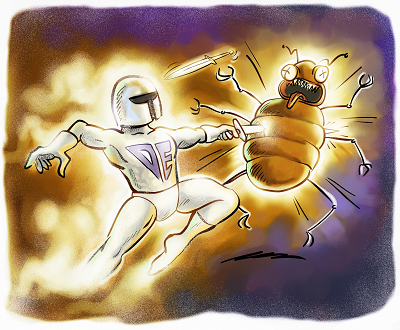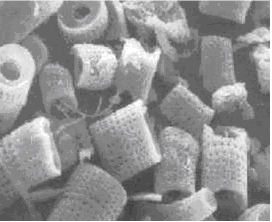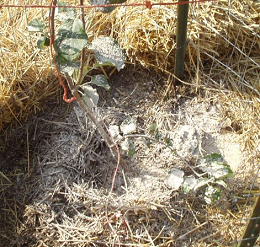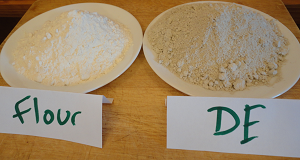Full Moon and Bugs, Bugs, Bugs... | Fighting Autism and Winning!

Diatomacious Earth (often referred to as "DE") is an off white talc-like powder that is the fossilized remains of marine phytoplankton. When sprinkled on a bug that has an exoskeleton (such as bed bugs, ants or fleas) it gets caught between their little exoskeleton joints. As they move, the diatomaceous earth acts like razor blades and cuts them up. But it doesn't hurt mammals. We can eat it. We do eat it! It's in lots of grain based foods because lots of grains are stored with diatomaceous earth to keep the bugs from eating
Diatomacious Earth (often referred to as "DE") is an off white talc-like powder that is the fossilized remains of marine phytoplankton. When sprinkled on a bug that has an exoskeleton (such as bed bugs, ants or fleas) it gets caught between their little exoskeleton joints. As they move, the diatomaceous earth acts like razor blades and cuts them up. But it doesn't hurt mammals. We can eat it. We do eat it! It's in lots of grain based foods because lots of grains are stored with diatomaceous earth to keep the bugs from eating the grain!
Die bugs! Die! Die! Die!
I have heard two explanations of how diatomaceous earth works.

One is that on a microscopic level, the diatomaceous earth particles are very sharp looking. These particles stick to an insect and get stuck between its exoskeleton joints. As the insect moves, it gets physically cut up.
The other explanation is that diatomaceous earth sticks to the insect and somehow causes them to dry out. I think this approach involves scratching the insects waxy layer which then allows precious moisture within the insect to get out. So their teeny tiny bug-innards turn into teeny tiny bug-innards-jerky.
A reader, Sue, in Washington state writes:
Both are true and connected. DE is almost pure silica (with some beneficial trace minerals); under a microscope, it looks like shards of glass (glass is made from silica). On any beetle-type insect that has a carapace, like fleas and cockroaches, the DE works under the shell and punctures the body, which then dehydrates and the insect dies. DE is totally nontoxic. There is no buildup of tolerance like there is to poisons because the method of killing is PHYSICAL, not chemical.

The important thing to us is that if an insect with an exoskeleton gets diatomaceous earth on them, they die. At the same time, we can rub it all over our skin, rub it in our hair, eat it .... whatever ... and we are unharmed.
Diatomaceous earth kills all bugs. It has been reported to be the most effective solution when fighting pests like fleas, ants and bed bugs.
Farmers dump food grade diatomaceous earth by big scoops in with grains when the grains are stored. It kills the insects that want to feast on the grain. This is a great improvement over the stuff they used to put in with the grain.
Farmers feed gobs of diatomaceous earth (food grade) to animals in the hopes that it will cure whatever ails them. Many farmers swear that the stuff kills all sorts of worms in their critters.
Many people eat a quarter cup of food grade diatomaceous earth every day. They mix it into juice. I have visited with several people that are keen on living past 100 years that believe that eating lots diatomaceous earth every day will help them with that goal. I have found references where it is cited for colon cleansing, parasite control and detox.

One strange thing about diatomaceous earth is that for it to work on killing bugs, you have to keep it dry. Even morning dew can make diatomaceous earth ineffective.
I have encountered over a dozen ignorant boobs that have proclaimed "Diatomaceous Earth does NOT work!" I have read this statement in all caps. In extra big fonts. With italics. And I've even had it screamed at me. I'm gonna stick with "ignorant boobs". On closer inspection of each case there is always a flaw. Usually the problem is that it was not used correctly. Diatomaceous earth is not a bait. If you put a little bit in a pile somewhere, the bugs are not drawn to it and invite all their friends. I kinda wonder if the pesticide companies pay people to go to internet forums and say this sort of thing. Diatomaceous earth is super cheap, non toxic, and generally more effective than anything the pesticide companies have to offer - so it kinda cuts into their profit margins a bit. I've been meaning to create an experiment to set the record straight on this topic, but a participant in the diatomaceous earth discussion, Stephanie, beat me to it:
I tried my own experiment with the diatomaceous earth to see how quickly it kills the fleas; I caught a few fleas and put them in a jar with a pinch of diatomaceous earth - all were dead within just a couple of hours.
It just doesn't get any more clear than that.
How safe is diatomaceous earth?
The only known problem for people, mammals and birds that I have ever been able to find any reference to is breathing it in. For food grade diatomaceous earth, there is only the bother of breathing in any dust. There exists another variety of diatomaceous earth that has been fiddled with so it can be used for pool filters. The pool grade stuff would be bad for you because it contains up to 70% "crystalline silica". My understanding is that if you work with the pool grade stuff all day, every day, for years, you could get cancer. Don't mess with the pool grade stuff. Food grade diatomaceous earth will contain less than 1% crystalline silica.
This article is really about the pure, food grade diatomaceous earth. I have to say "food grade" over and over or some nitwit will quote a small slice and then bring up the pool grade issues.
I have heard from two people that said that they won't use diatomaceous earth anymore because "the tiny particles cut my lungs!" --- (deep sigh goes here) All I can say is "Did you actually examine your lung with a microscope and watch the diatomaceous earth cut into it?" - of course, they did not. I think the truth behind these reports is that these folks heard how diatomaceous earth works, and when they would breathe in the dust, it would make them cough - just as breathing in flour or corn starch would make you cough. And then they thought of the sharpness at a microscopic level. My understanding is that when diatomaceous earth becomes moist, the sharp thing is no longer happening. That's why you have to keep it dry when you use it.

I have heard that people working in the diatomaceous earth (food grade) mines have no greater health problems than the people working in any other mines. (I would like to get some sources for this info - if anybody has a link, please email me)
As long as you are using food grade diatomaceous earth, you are perfectly safe. Even if you breathe in gobs of it. Of course, if you are asthmatic or have lung problems of any kind, I would think breathing in big gobs of any kind of dust would be a bad idea.
gimmie gimmie gimmie!
There are a lot of varieties of diatomaceous earth, so when you are shopping, be sure to get the right stuff!
Make sure that you get food grade diatomaceous earth. Some people make 3% of the food they eat be diatomaceous earth. There are claims at parasite control, longevity and all sorts of perks. I know that food grade diatomaceous earth is used heavily in storing grains - so you are probably already eating lots of diatomaceous earth every time you eat any bread, pasta or other grain based food.
Farmers feed food grade diatomaceous earth to their animals to reduce parasites and provide other benefits.
Some places sell the diatomaceous earth (food grade) mixed with other stuff. And that is something I do not recommend. When I see a label that says "97% diatomaceous earth" I have to wonder what the other 3% is. If the packaging is about killing bugs, is it some sort of toxin? Did they add something like borates or pyrethrin for a little extra kick? I don't want that!
Some places sell diatomaceous earth that is for swimming pool filters - that is definitely what you do NOT want.
Some places sell an 8 ounce shaker. I think it is wise to get at least a few pounds of the stuff. It keeps well (it's already millions of years old) and is useful for so many things. And if you get too little, you are likely to not use enough.
So I've done a lot of research on this .... and I've used diatomaceous earth from about eight different sources ... and here is what I'm recommending: This is food grade diatomateous earth guaranteed to be "less than 0.5% crystaline silica". After a long talk with the guy that runs this outfit, I found out that most of this diatomaceous earth runs about 0.1% to 0.2% crystaline silica. By far the best I've ever heard of.
This next one is food grade diatomaceous earth where all they would tell me is that it has less than 0.5% crystalline silica. Not as good as the stuff above, but still way better than the others I could find:
?
http://www.richsoil.com
Source: http://www.chicagonow.com/fighting-autism-and-winning/2012/09/full-moon-and-bugs-bugs-bugs/
sweet potato pie sweet potato pie twas the night before christmas norad santa epic beard man nfl standings giants vs jets

0টি মন্তব্য:
একটি মন্তব্য পোস্ট করুন
এতে সদস্যতা মন্তব্যগুলি পোস্ট করুন [Atom]
<< হোম